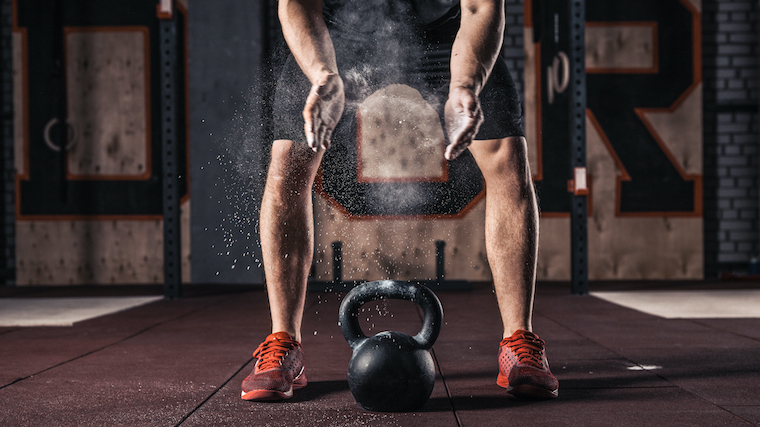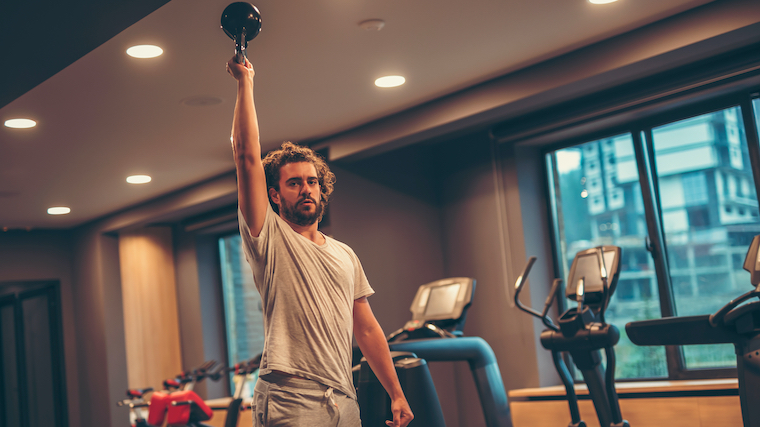It can be tough to track progress when working with kettlebells. If you only have access to a limited weight range, it can feel like a game of diminishing returns. How can you tell if you’re getting stronger when, for example, you’ve only got a single 20 kilogram bell to work with?
Integrating kettlebell benchmarks into your routine can help you figure out what progress you’ve made and where you need to improve so that you can get the most out of your kettlebell training.
Editor’s note: This article is an op-ed. The views expressed herein and in the video are the author’s and don’t necessarily reflect the views of BarBend. Claims, assertions, opinions, and quotes have been sourced exclusively by the author.
Why Use Benchmark Workouts?
Becoming a well-rounded strength athlete is about more than watching your numbers creep up. It’s also about increasing your overall athleticism, ability to handle complex, full-body movements, and mental toughness. Fortunately, kettlebells are excellent for all of that.
[Related: 3 Tips for Designing a Single Kettlebell Workout Program]
While it’s great to go up in weight with kettlebells, most gyms have a relatively low upper limit on kettlebell weight — not to mention that your goal might not, in fact, be to swing a 50 kilogram bell. Enter benchmark workouts: these relatively quick and specific fitness assessments can help you figure out exactly how far you’ve come.
What Is A Benchmark Workout?
Think of a benchmark workout as testing your one rep max (1RM), but oftentimes with a lot less stress on your body. Testing your 1RM at the beginning of a particular training cycle, and then testing it again at the end of said cycle will prove what progress was made.
A benchmark workout is similar. For example, seeing how long it takes to complete 100 swings at the beginning of your cycle versus how long 100 swings takes again toward the end of your cycle. Write the info down both times so you can see what changes you’ve made, and… voila! You’ve successfully used a benchmark workout to track your progress.
How To Use Benchmark Workouts
First things first: you’ve got to record what you’re doing. Grab a workout journal and get very specific in what you write down. Sure, you want your weight, rep number, time… whatever’s relevant to the particular benchmark you’re trying to hit, but you should also take careful note of your rate of perceived exertion (RPE). If you’re a stickler for this kind of thing and have an accurate way to gauge — your heart rate right after your workout.

You might be able to pull off a solid Turkish get-up after learning the basics. You might struggle to perform it with an eight kilogram bell the first few times, but then cruise through that weight as a warm-up next time. Take note of the fact that it’s getting easier for you.
If you see your numbers hover close together, i.e. plateauing, has all your hard work been for nothing? Analyzing the specifics could be the major differentiating factor — perhaps you struggled to breathe or maintain your grip during the first benchmark, and had a much easier go of it the second time. In other words, your numbers might be similar, but your effort the second time was easier. That’s progress!
So, make sure you’re writing little things like RPE down. It can offer a more holistic view of your training progress.
Kettlebell Benchmarks For All Levels
No benchmark workouts exist in isolation, or exist exclusively in categories like “beginner” or “advanced.” You should always be checking in on kettlebell fundamentals like your kettlebell deadlift and swing form, especially as your fitness and skill level get more advanced. It’s easy to start skimping on form when not paying routine mind to fundamentals.
On the flip side, if your general fitness level is solid, but you just haven’t had much opportunity to work with kettlebells before, you might find swing technique to come pretty naturally to you. If your athleticism is already there and you catch on to swing form quickly enough, you might be able to dive into 100 swings for time pretty easily. It all depends on your body and your needs — just always, for the love of all things kettlebell, make sure your form is locked in.
Beginner Kettlebell Benchmarks
Nothing in fitness is strictly for “beginners” or “advanced” lifters — everything is a continuum. Even the most experienced lifters need to always check in on their most fundamental movements. That said, if you’re new to kettlebells or new to fitness generally, you definitely shouldn’t dive right into 100 swings for time. Meet yourself where you’re at and always check in with the following movement-based benchmarks.
Kettlebell Deadlift
You need to be able to properly deadlift a kettlebell before you can swing it. Set up with the bell between your feet with the handle in line with your midfoot, as though it were a barbell. Make sure your hinge pattern is proper — forward with a soft bend in your knees until you feel your hamstrings engage. Then bend your knees further — emphasizing your hinge rather than a squat — if you still need to get lower to grasp the bell’s handle.
Deadlift like you would a barbell, but be extra cautious not to hyperextend your back on lockout. There will be no barbell coming up against your thighs, so you’ll have to cue yourself by squeezing your glutes to protect your low back.
For this benchmark, check in with what weight you can comfortably lift for 15 reps, leaving one or two in the tank.
Kettlebell Swing
Start with your double-handed swing and progress to one-handed alternating swings. Wherever you are in your kettlebell journey, you can use a swing benchmark to help keep track of your training.
For both types of swings, start with the bell a foot or two directly in front of you with your feet roughly in your preferred squat stance. Grasp the bell in the middle of the handle. It might be a tight squeeze depending on your handle/hand size, but your fingers should be relatively light in their grip anyway. When the bell reaches the end of its hip-snap momentum near chest height, you should be able to flutter the tops of your fingers away from the bell. In Laymen’s terms, don’t squeeze the crap out of it.

To start the swing, drag the bell back behind you like you’re hiking a football, while keeping the body above your knees at all times. Depending on your limb length, this will change the shape of your hinge and the bend of your arms slightly. No matter what, make sure that your swing is being driven by a powerful hinge and hip snap. Protect your neutral spine by squeezing your glutes at the top of each swing.
For your benchmark, perform 20 swings comfortably with the heaviest weight you can do with good form (20 total, so ten per side if you’re testing your one-handed alternating swings).
Turkish Get-Up
Turkish get-ups are such technically demanding moves that it’s tempting to put them in a more advanced category. But, they are also so fundamental to disciplined, controlled movement that they could be considered essential building blocks for any and all forms of lifting — so, here they are.
Three general pieces of advice that may get overlooked for a lot of people when you’re learning proper Turkish-get up form:
- Breath — exhale with each new component of the move, inhaling in the soft moments between movements when transitioning positions.
- Gaze — always maintain eye contact with the bell. This will protect your spine and make sure you’re keeping your shoulder packed and close to your ear.
- Foot — when you’re peeling yourself off the ground at the start of your get-up, make sure that the foot you’re extending long and slightly out to the side stays on the ground. Just like with a sit up twist, it’s easy to pop your long foot off the ground to help you get into position — but you want to drive your heel down into the ground to maximize core engagement and make sure you’re not compensating for a lack of core strength with poor movement quality.
For your benchmark, start by seeing how many perfect Turkish get-up reps you can perform with a light weight kettlebell. Record that number (per side), and see how it creeps up as you graduate to more moderate and heavy weights.
Intermediate Kettlebell Benchmarks
Experience with a barbell, cardiovascular fitness, and grip strength really starts to matter here. These benchmarks can help keep track of your kettlebell training, but remember: you’ve got to work up to them.
The moment you get good kettlebell form down is not the moment to say, “cool cool, now I’ll try to do 100 reps as fast as I can.” Just… don’t do that. Work up to these benchmark workouts — earn them just like you would earn a max effort day with a barbell.
Kettlebell Clean
Performing a proper kettlebell clean really starts and ends with your grip. Don’t go for the center of the handle like you do with swings. Instead, take an offset grip (with the pad between your thumb and index finger up against the curve of the handle) to avoid the kettlebell forearm flop that absolutely nobody wants to experience. This way, you’ll weave your hand through the bell on its way to rack position, rather than trying to flip it over your wrist and give yourself extreme bruises the next day.
The other cue to keep in mind is zipping up a side pocket:
- Keep your arm tucked as close to your rib cage as possible.
- Use momentum from your hips to draw the bell up your side — almost like you were zipping closed a vertical side pocket on your way up.
- Finish in rack position.
If you want to add a bit of extra “fun” — sink down into a front-racked offset squat with each rep. Whichever method of cleaning you choose, keep it consistent between your benchmark workouts so you have an accurate measure of your progress.

For your benchmark, see what weight you can comfortably clean for 12 solid reps per side, leaving one or two in the tank.
Max Swings In Ten Minutes
This one is pretty self-explanatory: perform as many kettlebell swings as possible in ten minutes, resting only as needed.
This is a very important one to record your RPE for. If your mechanics are excellent across multiple benchmark workouts, you might wind up maintaining similar-ish numbers. Sure, they might go up as your grip strength and general stamina improve, but you might not find your number skyrocketing up like you hope — that’s okay.
Keep track of how difficult it is for you to reach your max number, how many times you have to put down the bell, and how long you break for when you do put it down. Take note of your limiting factor — was it your grip strength? Your heart rate? Your mental fatigue? As you perform this workout over time, you can note differences in your mental toughness as well as your physical factors, which definitely makes this one of my favorites.
100 Swings For Time
Performing 100 swings for time is also fairly self-explanatory, and you want to pay attention to the same indicators as above. How often do you have to break, if at all? How difficult is your effort overall? What’s your mental state like? Keep note of all these things, not just your numbers, to make your benchmark workout as effective as possible.
Advanced Kettlebell Benchmarks
The more advanced you get in your kettlebell benchmarks, the more you’ll be able to actively check in on your mental endurance and toughness. This is definitely one of the more rewarding parts of kettlebell training. If your form is dialed in, sometimes it’s just about pushing past mental fatigue, and keeping track of those changes can be just as inspiring as watching your weights go up (if not moreso).
Double Kettlebell Clean and Press
If you’ve encountered the kettlebell clean, it’s relatively simple to add a press to the top of it. But now, you’re going to measure your ability to perform a double kettlebell clean and press, with a kettlebell in each hand.
Start with much lower weight than you think you need and go from there. The biggest challenge here is making sure that the bells don’t clang together on the way up. Make sure you’re keeping both bells strictly along your rib cage on either side. You might want to widen your foot stance, as well, to keep a more stable base to compensate for the extra difficult mechanics.
For your benchmark, start by refining your technique, and then see what weight you can get to ten perfect reps with. Squeeze your glutes on the presses, being careful not to hyperextend your low back to compensate for any shoulder weakness or instability.
Kettlebell Snatch
The kettlebell snatch is not to be trifled with, but it can become a very important full-body staple once you get the hang of it. Start with a swing, turn it into a high pull, slip your arm under the bell, and use your momentum to lock it out overhead. Flip it back over your wrist amd let momentum swing it down and up again to repeat. It sounds simple, but the move is anything but.
For your benchmark, make it a goal to perform two perfect reps back-to-back (per side). You might find, especially in the beginning of your training, that you have to pepper a couple of regular one-handed swings into the mix before being able to do consecutive reps, and that’s okay — that’s why it’s a benchmark!
21-15-9 Squat Cleans And Presses For Time
45 reps is nothing to scoff at, especially if you’re doing this benchmark workout with a single kettlebell at a time — which means you’ll be doing 90 total reps (21-15-9 per side). The essence of this one is both simple and torturous: perform 21 reps, then 15, then 9.
Go unbroken if you can, but if you can’t, don’t fret: just take note of that to compare to your next benchmark. Add a time component and this will be a destructive workout all on its own, as well as a brilliant way to measure your overall progress.
On Your Mark
Your benchmarks help guide your kettlebell training. Keep records of your progress as you go along. The beautiful thing about benchmark workouts for kettlebells is that you can return to them each new cycle see how much stronger and more athletic you’ve become overall. Always return to your fundamentals along your journey to grease those basic grooves and keep your form as locked in as your numbers.
Feature image via Shutterstock/nelic.